The Different Properties of Geopolymer Composites Reinforced with Flax Fibers and Carbon Fibers
Abstract
1. Introduction
2. Materials and Methods
2.1. Materials
2.2. Methods
- Specimen preparation: Representative samples were selected and prepared in the form of cylinders or cubes, according to specific regulations.
- Initial drying: Samples were carefully dried to remove any pre-existing moisture.
- Immersion in water: The dried samples were completely immersed in water for a specified period. In the analyzed case, the material was immersed in water for 5 days, and the measurements were taken two times per day to understand the absorption capacity over time.
- Subsequent drying: After immersion, the samples were removed from the water and dried again to remove excess surface water. This process was carried out each time the samples were taken out to take measurements.
- Weight after absorption: The weight of the samples after water absorption was measured.
3. Results and Discussion
3.1. Compressive Test and Flexural Test of Geopolymers
3.2. Water Absorption of Geopolymers
3.3. Abrasion Test of Geopolymers
3.4. Microstructure of Geopolymers
3.5. Chemical Composition of Geopolymers
3.6. Crystal Structure of Geopolymers
4. Further Directions for the Studies
5. Conclusions
- The addition of carbon fibers showed an improvement in the compressive strength of the material, obtaining the highest value.
- Furthermore, it was observed that the addition of fibers did not improve the mechanical properties of the geopolymers in terms of flexural strength. As a result, the pure geopolymer showed the highest flexural strength.
- The authors also observed that the fibers reduced the water absorption and abrasion resistance of the geopolymers, indicating a higher porosity and lower durability of the composites.
- The SEM analysis revealed the microstructure and the fiber–matrix interface of the composites, showing different phenomena such as fiber fracture, pull-out, debonding, and bridging.
- The XRF and XRD analyses confirmed the chemical and crystal structures of the geopolymers and illustrated that they widely depend on the raw materials, showing the presence of alumina and silica as the main elements and oxides. Fiber addition did not significantly influence chemical composition.
Author Contributions
Funding
Institutional Review Board Statement
Informed Consent Statement
Data Availability Statement
Conflicts of Interest
References
- Korniejenko, K.; Łach, M.; Chou, S.Y.; Lin, W.T.; Cheng, A.; Hebdowska-Krupa, M.; Gadek, S.; Mikuła, J. Mechanical Properties of Short Fiber-Reinforced Geopolymers Made by Casted and 3D Printing Methods: A Comparative Study. Materials 2020, 13, 579. [Google Scholar] [CrossRef] [PubMed]
- Korniejenko, K.; Łach, M.; Marczyk, J.; Ziejewska, C.; Halyag, N.P.; Mucsi, G. Fly Ash as a Raw Material for Geopolymerisation-Mineralogical Composition and Morphology. In IOP Conference Series: Materials Science and Engineering; IOP Publishing Ltd.: Bristol, UK, 2019; Volume 706. [Google Scholar]
- Ponomar, V.; Luukkonen, T.; Yliniemi, J. Revisiting Alkali-Activated and Sodium Silicate-Based Materials in the Early Works of Glukhovsky. Constr. Build. Mater. 2023, 398, 132474. [Google Scholar] [CrossRef]
- Moujoud, Z.; Sair, S.; Ait Ousaleh, H.; Ayouch, I.; El Bouari, A.; Tanane, O. Geopolymer Composites Reinforced with Natural Fibers: A Review of Recent Advances in Processing and Properties. Constr. Build. Mater. 2023, 388, 131666. [Google Scholar] [CrossRef]
- Ünal, M.T.; Gökçe, H.S.; Ayough, P.; Alnahhal, A.M.; Şimşek, O.; Nehdi, M.L. Nanomaterial and Fiber-Reinforced Sustainable Geopolymers: A Systematic Critical Review. Constr. Build. Mater. 2023, 404, 133325. [Google Scholar] [CrossRef]
- de Lima, T.; de Azevedo, A.; Marvila, M.; Candido, V.; Fediuk, R.; Monteiro, S. Potential of Using Amazon Natural Fibers to Reinforce Cementitious Composites: A Review. Polymers 2022, 14, 647. [Google Scholar] [CrossRef] [PubMed]
- Lilargem Rocha, D.; Tambara Júnior, L.; Marvila, M.; Pereira, E.; Souza, D.; de Azevedo, A. A Review of the Use of Natural Fibers in Cement Composites: Concepts, Applications and Brazilian History. Polymers 2022, 14, 2043. [Google Scholar] [CrossRef] [PubMed]
- Zhang, D.; Wang, Y.; Zhang, T.; Yang, Q. Engineering and Microstructural Properties of Carbon-Fiber-Reinforced Fly-Ash-Based Geopolymer Composites. J. Build. Eng. 2023, 79, 107883. [Google Scholar] [CrossRef]
- Qin, L.; Yan, J.; Zhou, M.; Liu, H.; Wang, A.; Zhang, W.; Duan, P.; Zhang, Z. Mechanical Properties and Durability of Fiber Reinforced Geopolymer Composites: A Review on Recent Progress. Eng. Rep. 2023, 5, e12708. [Google Scholar] [CrossRef]
- Rajendran, M.; Bakthavatchalam, K.; Leela Bharathi, S.M. Review on the Hybridized Application of Natural Fiber in the Development of Geopolymer Concrete. J. Nat. Fibers 2023, 20, 2178578. [Google Scholar] [CrossRef]
- Silva, G.; Kim, S.; Castañeda, A.; Donayre, R.; Nakamatsu, J.; Aguilar, R.; Korniejenko, K.; Łach, M.; Mikuła, J. A Comparative Study of Linen (Flax) Fibers as Reinforcement of Fly Ash and Clay Brick Powder Based Geopolymers. In IOP Conference Series: Materials Science and Engineering; Institute of Physics Publishing: Bristol, UK, 2018; Volume 416. [Google Scholar]
- Mohamed, O.; Zuaiter, H. Fresh Properties, Strength, and Durability of Fiber-Reinforced Geopolymer and Conventional Concrete: A Review. Polymers 2024, 16, 141. [Google Scholar] [CrossRef]
- Abdullah, M.M.A.; Hussin, K.; Bnhussain, M.; Ismail, K.N.; Ibrahim, W.M.W. Mechanism and Chemical Reaction of Fly Ash Geopolymer Cement—A Review. Int. J. Pure Appl. Sci. Technol. 2011, 6, 35–44. [Google Scholar]
- Korniejenko, K.; Kejzlar, P.; Louda, P. The Influence of the Material Structure on the Mechanical Properties of Geopolymer Composites Reinforced with Short Fibers Obtained with Additive Technologies. Int. J. Mol. Sci. 2022, 23, 2023. [Google Scholar] [CrossRef] [PubMed]
- Füchtbauer, H. Sedimente und Sedimentgesteine, 4th ed.; Schweizerbart: Stuttgart, Germany, 1988. [Google Scholar]
- Lin, T.; Jia, D.; He, P.; Wang, M.; Liang, D. Effects of Fiber Length on Mechanical Properties and Fracture Behavior of Short Carbon Fiber Reinforced Geopolymer Matrix Composites. Mater. Sci. Eng. A 2008, 497, 181–185. [Google Scholar] [CrossRef]
- Růžek, V.; Dostayeva, A.M.; Walter, J.; Grab, T.; Korniejenko, K. Carbon Fiber-Reinforced Geopolymer Composites: A Review. Fibers 2023, 11, 17. [Google Scholar] [CrossRef]
- Assaedi, H.; Alomayri, T.; Shaikh, F.U.A.; Low, I.M. Characterisation of Mechanical and Thermal Properties in Flax Fabric Reinforced Geopolymer Composites. J. Adv. Ceram. 2015, 4, 272–281. [Google Scholar] [CrossRef]
- Silva, G.; Kim, S.; Aguilar, R.; Nakamatsu, J. Natural Fibers as Reinforcement Additives for Geopolymers—A Review of Potential Eco-Friendly Applications to the Construction Industry. Sustain. Mater. Technol. 2020, 23, e00132. [Google Scholar] [CrossRef]
- Korniejenko, K.; Figiela, B.; Šimonová, H.; Kucharczyková, B.; Duarte Guigou, M.; Łach, M. The Influence of Fibre Pre-Treatment on the Mechanical Properties of the Geopolymer Composites. MATEC Web Conf. 2020, 322, 01012. [Google Scholar] [CrossRef]
- Bayram, F. Data Mining Techniques for the Prediction of Bohme Surface Abrasion Rates from Rock Properties. J. Test. Eval. 2020, 48, 323–332. [Google Scholar] [CrossRef]
- Smoleń, W.; Marczyk, J.; Łach, M.; Nguyen, T.X.; Korniejenko, K. Effect of Microsilica Addition on Properties of Geopolymer Composites. J. Achiev. Mater. Manuf. Eng. 2023, 121, 46–59. [Google Scholar] [CrossRef]
- Sharma, U.; Gupta, N.; Bahrami, A.; Özkılıç, Y.O.; Verma, M.; Berwal, P.; Althaqafi, E.; Khan, M.A.; Islam, S. Behavior of Fibers in Geopolymer Concrete: A Comprehensive Review. Buildings 2024, 14, 136. [Google Scholar] [CrossRef]
- Walbrück, K.; Drewler, L.; Witzleben, S.; Stephan, D. Factors Influencing Thermal Conductivity and Compressive Strength of Natural Fiber-Reinforced Geopolymer Foams. Open Ceram. 2021, 5, 100065. [Google Scholar] [CrossRef]
- Jan, A.; Pu, Z.; Khan, I.; Khubaib, M. A Comprehensive Review on the Effect of Fibers on Fresh and Engineering Properties of Geopolymer Concrete. Iran. J. Sci. Technol. Trans. Civ. Eng. 2024, 48, 1–24. [Google Scholar] [CrossRef]
- Chen, K.; Wang, Y.; Min, W.; Chen, J.; Wu, R.; Peng, Y.; Zhao, Y.; Xia, J. Performance Characteristics of Micro Fiber-Reinforced Ambient Cured One-Part Geopolymer Mortar for Repairing. Constr. Build. Mater. 2024, 415, 135086. [Google Scholar] [CrossRef]
- Hakeem, I.Y.; Zaid, O.; Arbili, M.M.; Alyami, M.; Alhamami, A.; Alharthai, M. A State-of-the-Art Review of the Physical and Durability Characteristics and Microstructure Behavior of Ultra-High-Performance Geopolymer Concrete. Heliyon 2024, 10, e24263. [Google Scholar] [CrossRef] [PubMed]
- Thokchom, S.; Ghosh, S.; Ghosh, P. Effect of water absorption, porosity and sorptivity on durability of geopolymer mortars. ARPN J. Eng. Appl. Sci. 2009, 4, 28–32. [Google Scholar]
- Nuaklong, P.; Wongsa, A.; Boonserm, K.; Ngohpok, C.; Jongvivatsakul, P.; Sata, V.; Sukontasukkul, P.; Chindaprasirt, P. Enhancement of Mechanical Properties of Fly Ash Geopolymer Containing Fine Recycled Concrete Aggregate with Micro Carbon Fiber. J. Build. Eng. 2021, 41, 102403. [Google Scholar] [CrossRef]
- Kabay, N. Abrasion Resistance and Fracture Energy of Concretes with Basalt Fiber. Constr. Build. Mater. 2014, 50, 95–101. [Google Scholar] [CrossRef]
- Celik, A.; Yilmaz, K.; Canpolat, O.; Al-mashhadani, M.M.; Aygörmez, Y.; Uysal, M. High-Temperature Behavior and Mechanical Characteristics of Boron Waste Additive Metakaolin Based Geopolymer Composites Reinforced with Synthetic Fibers. Constr. Build. Mater. 2018, 187, 1190–1203. [Google Scholar] [CrossRef]
- Zuaiter, M.; El-Hassan, H.; El-Maaddawy, T.; El-Ariss, B. Properties of Slag-Fly Ash Blended Geopolymer Concrete Reinforced with Hybrid Glass Fibers. Buildings 2022, 12, 1114. [Google Scholar] [CrossRef]
- Lazorenko, G.; Kasprzhitskii, A.; Kruglikov, A.; Mischinenko, V.; Yavna, V. Sustainable Geopolymer Composites Reinforced with Flax Tows. Ceram. Int. 2020, 46, 12870–12875. [Google Scholar] [CrossRef]
- Al-mashhadani, M.M.; Canpolat, O.; Aygörmez, Y.; Uysal, M.; Erdem, S. Mechanical and Microstructural Characterization of Fiber Reinforced Fly Ash Based Geopolymer Composites. Constr. Build. Mater. 2018, 167, 505–513. [Google Scholar] [CrossRef]
- Murali, G. Recent Research in Mechanical Properties of Geopolymer-Based Ultra-High-Performance Concrete: A Review. Def. Technol. 2024, 32, 67–88. [Google Scholar] [CrossRef]
- Payakaniti, P.; Pinitsoontorn, S.; Thongbai, P.; Amornkitbamrung, V.; Chindaprasirt, P. Electrical Conductivity and Compressive Strength of Carbon Fiber Reinforced Fly Ash Geopolymeric Composites. Constr. Build. Mater. 2017, 135, 164–176. [Google Scholar] [CrossRef]
- Subramanian, S.; Davis, P.R.; Thomas, B.S. Sustainable Engineered Geopolymer Composites: A Study on the Potential of Fly Ash, BOF Slag, and Iron Ore Tailings. Environ. Eng. Res. 2024, 29, 230540. [Google Scholar] [CrossRef]
- Kar, A.; Pilani, B. Characterizations of Concretes with Alkali-Activated Binder and Correlating Their Properties from Micro-to Specimen Level. Ph.D. Thesis, West Virginia University, Morgantown, WV, USA, 2013. [Google Scholar]
- Gao, J.; Yang, Z.; Pi, Z.; Wu, Y.; Bai, T.; Jin, W. Preparation and Performance Study of a Novel Conductive Geopolymer. Constr. Build. Mater. 2024, 411, 134388. [Google Scholar] [CrossRef]
- Ahmed, J.K.; Atmaca, N.; Khoshnaw, G.J. Building a Sustainable Future: An Experimental Study on Recycled Brick Waste Powder in Engineered Geopolymer Composites. Case Stud. Constr. Mater. 2024, 20, e02863. [Google Scholar] [CrossRef]
- IS 1237; Cement Concrete Flooring Tiles—Specification. Bureau of Indian Standards (BIS): New Delhi, India, 2012.
- Ganesan, N.; Abraham, R.; Deepa Raj, S. Durability Characteristics of Steel Fibre Reinforced Geopolymer Concrete. Constr. Build. Mater. 2015, 93, 471–476. [Google Scholar] [CrossRef]

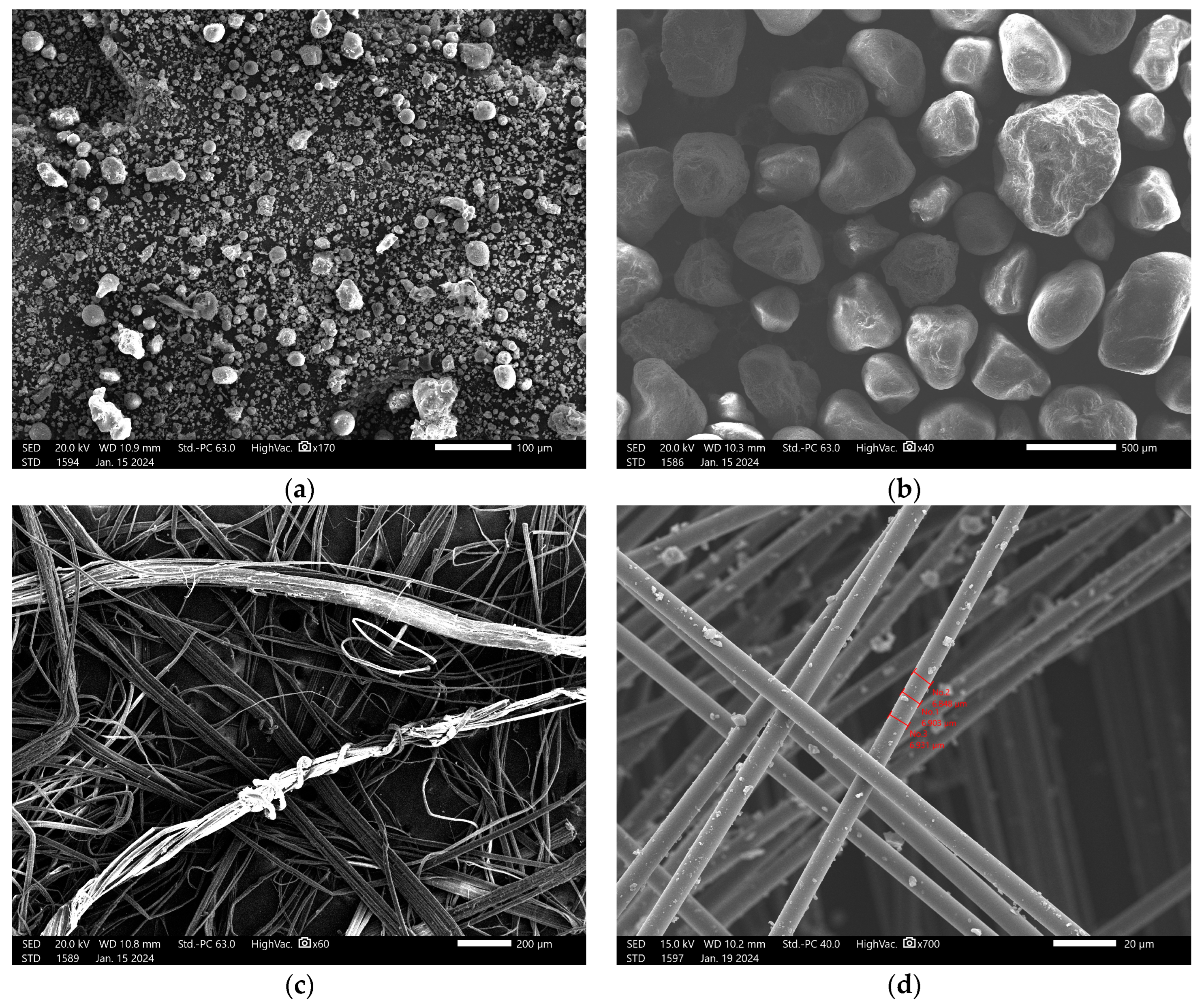
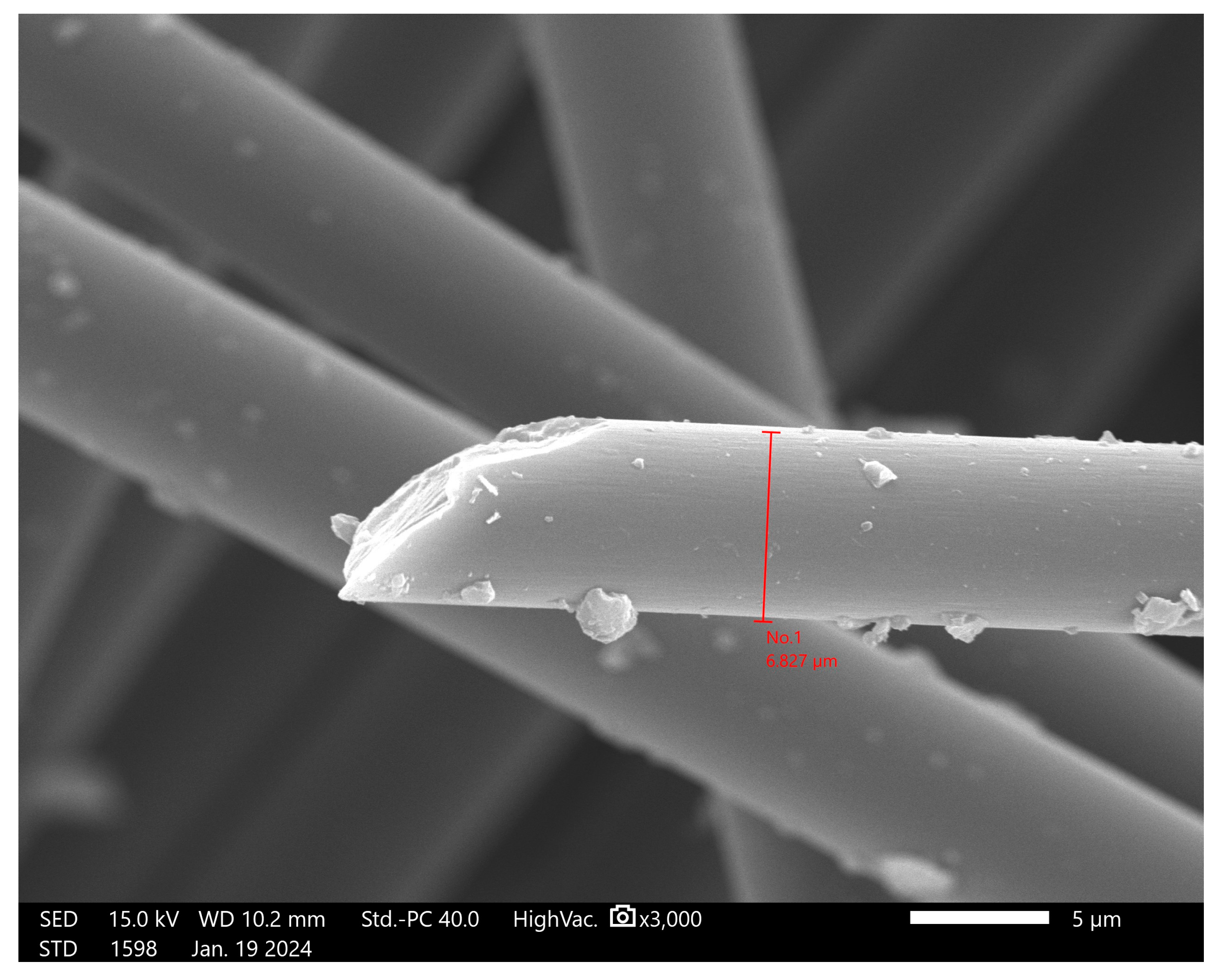

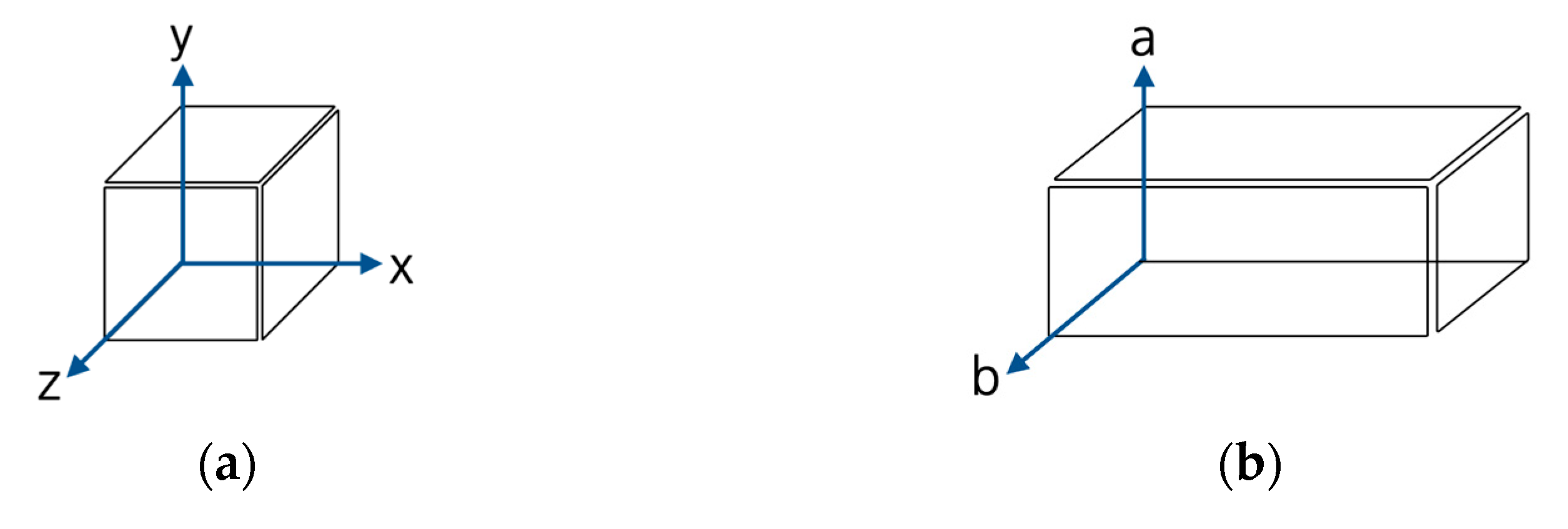
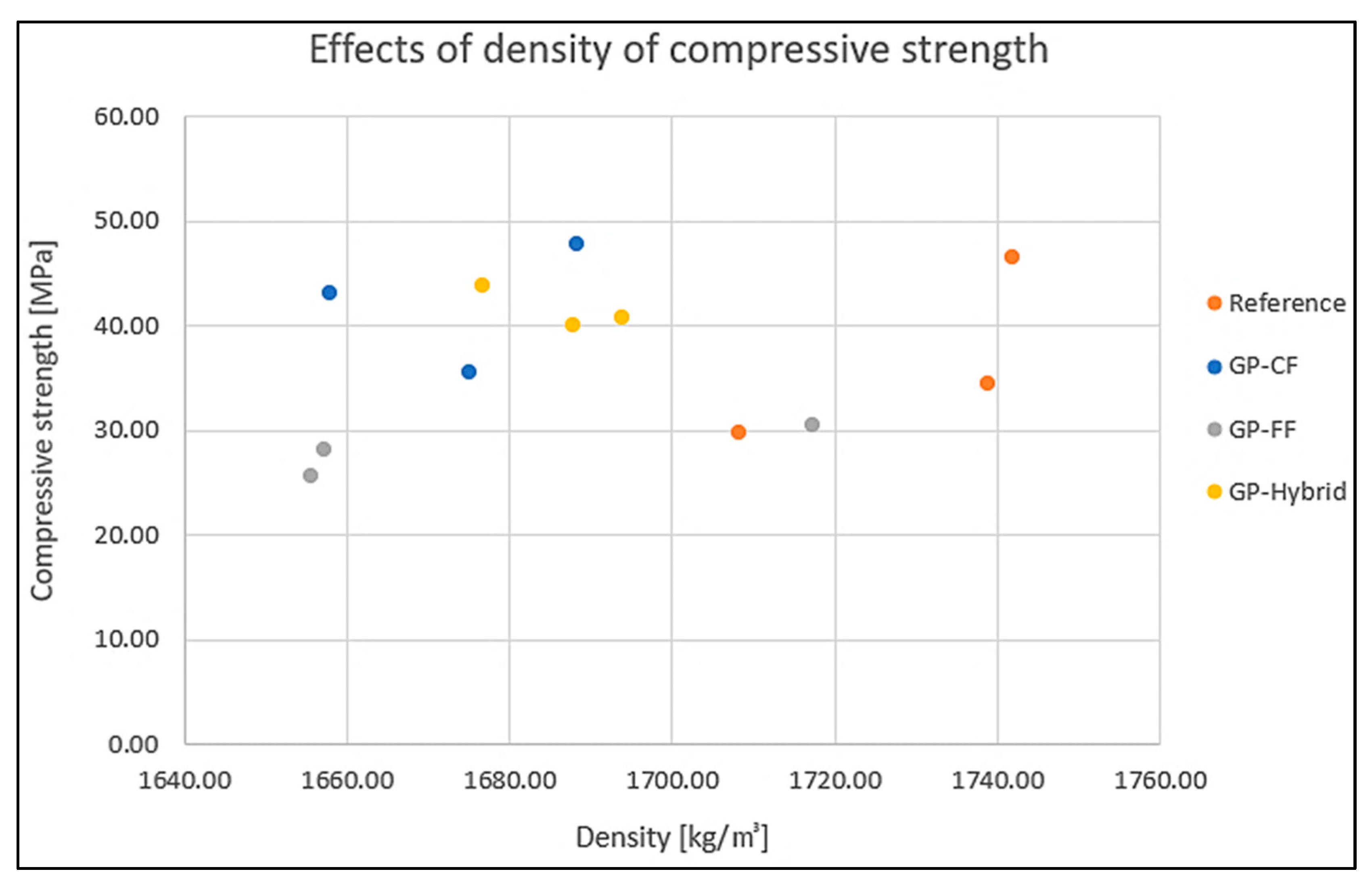

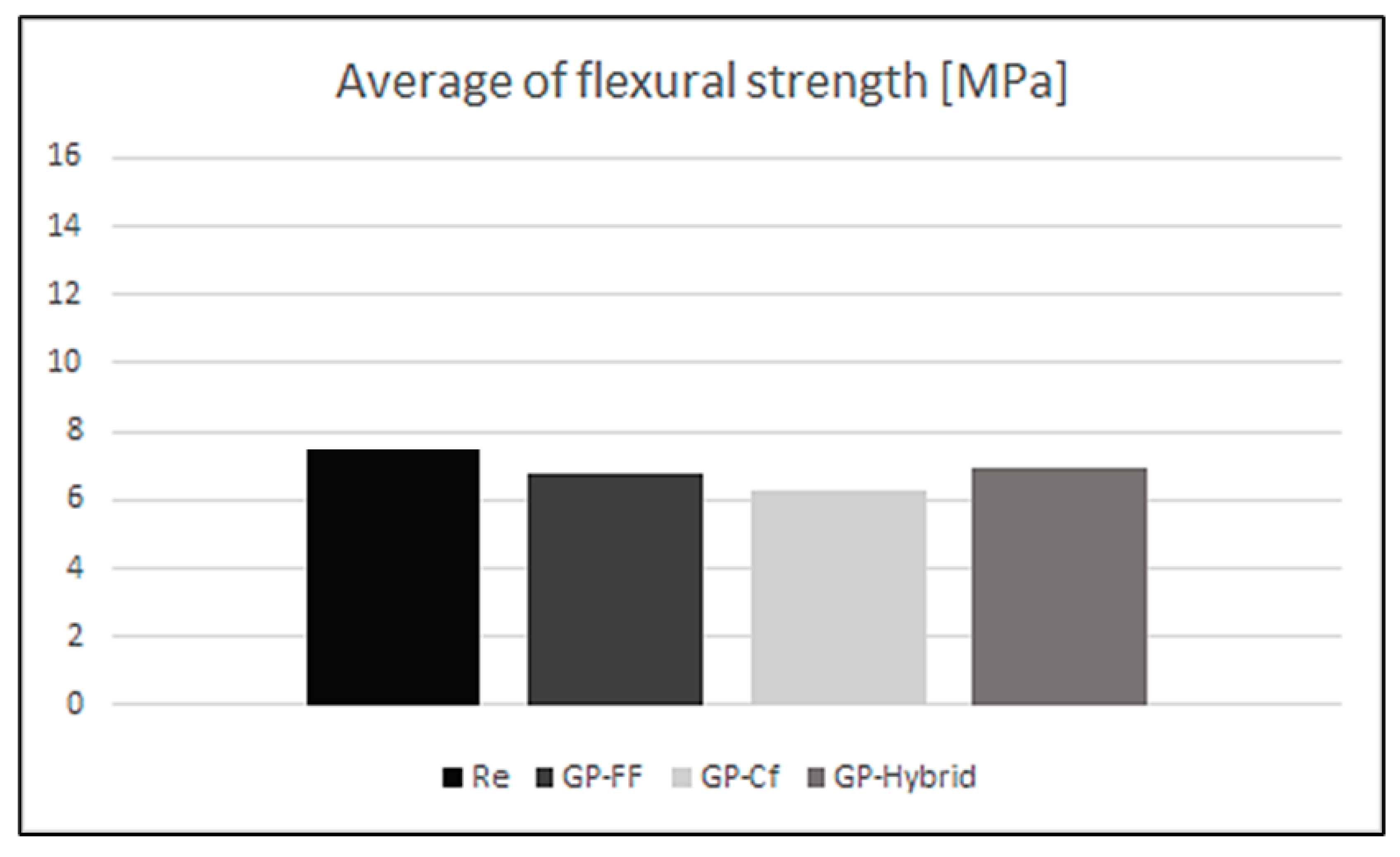
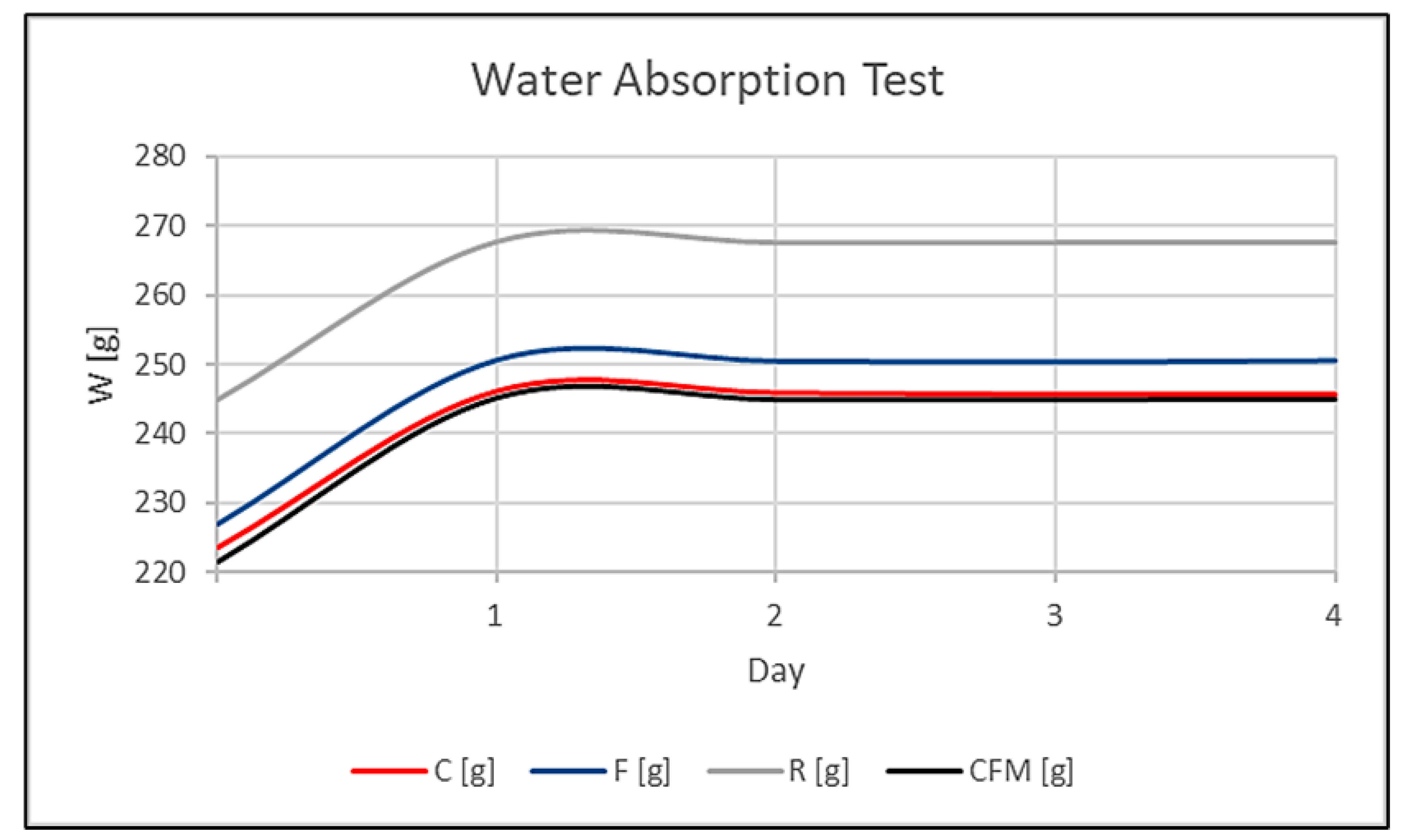
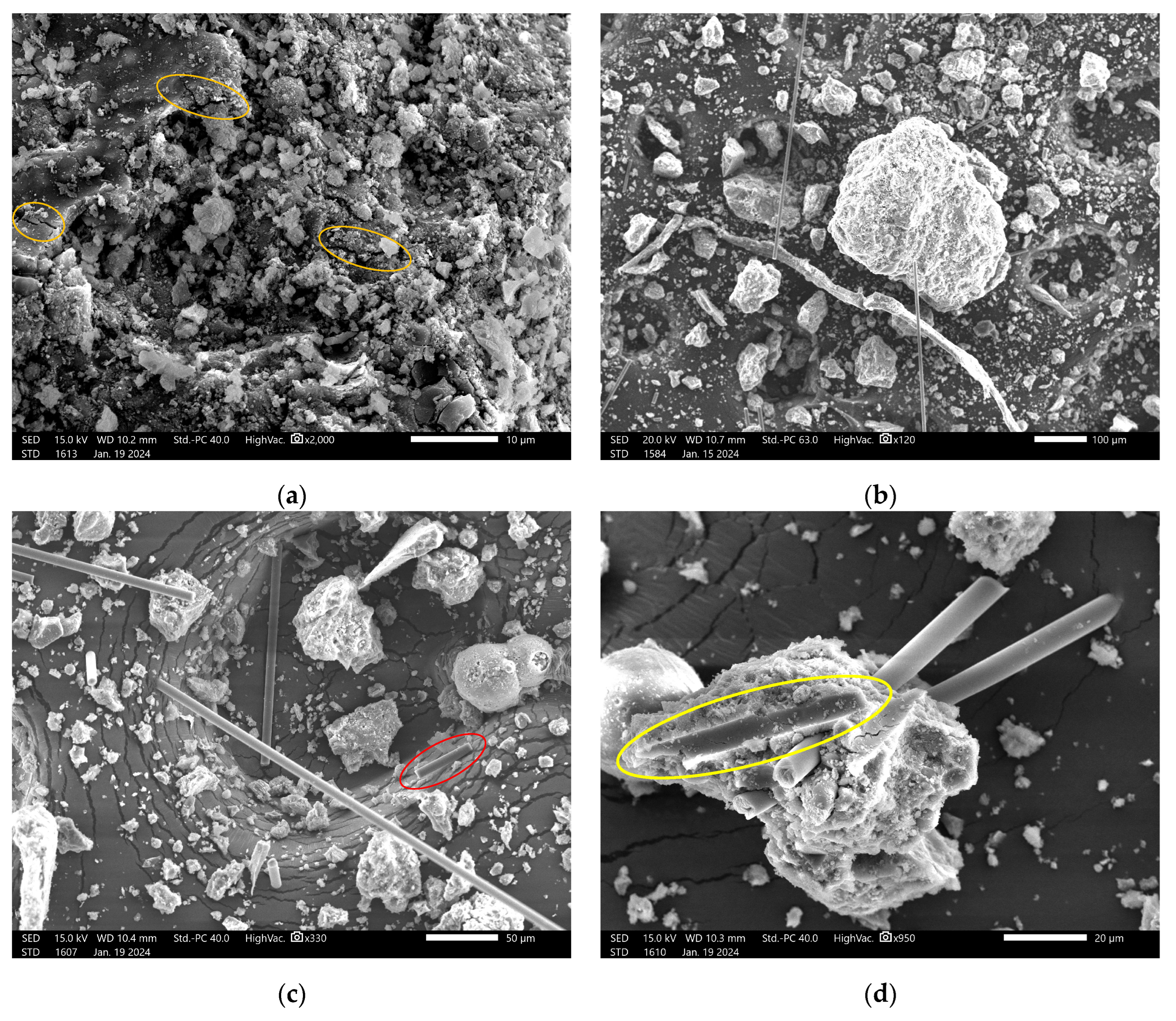
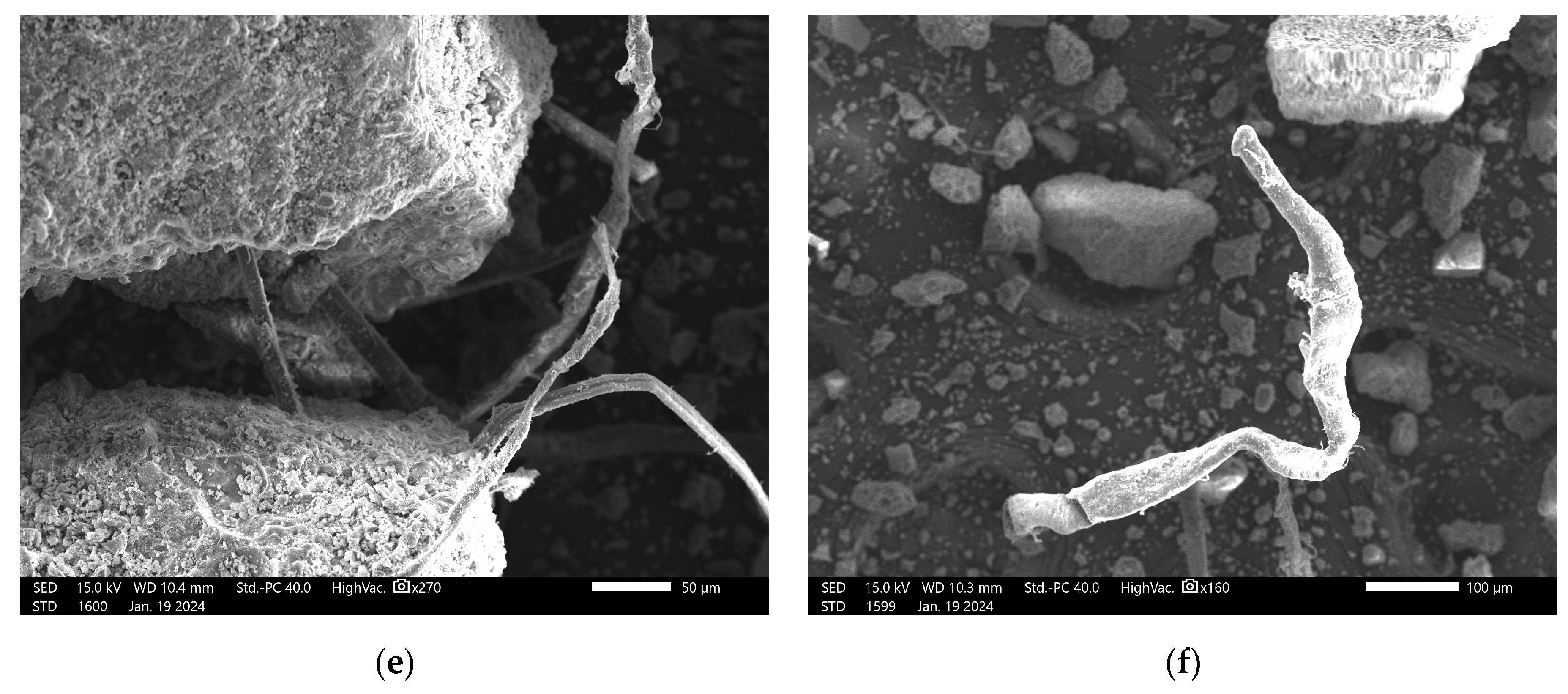

| Element | FA, Content [%] | Sand, Content [%] |
|---|---|---|
| Si | 45.830 | 94.258 |
| Al | 20.374 | 0.832 |
| Fe | 15.822 | 1.015 |
| K | 6.868 | 0.809 |
| Ca | 6.646 | 1.041 |
| Ti | 2.096 | 0.111 |
| S | 1.274 | 0.483 |
| Mn | 0.275 | 0.702 |
| V | 0.168 | - |
| Sr | 0.167 | - |
| Zn | 0.107 | - |
| Zr | 0.088 | - |
| P | - | 0.221 |
| Cr | - | 0.140 |
| Yb | - | 0.098 |
| Au | - | 0.075 |
| Cl | - | - |
| Other elements | <0.05 | <0.05 |
| Compound | FA, Content [%] | Sand, Content [%] |
|---|---|---|
| SiO2 | 54.241 | 97.215 |
| Al2O3 | 25.683 | 0.974 |
| Fe2O3 | 8.894 | 0.376 |
| CaO | 3.997 | 0.399 |
| K2O | 3.802 | 0.270 |
| TiO2 | 1.466 | - |
| SO3 | 1.404 | 0.340 |
| MnO | 0.141 | 0.234 |
| V2O5 | 0.111 | - |
| SrO | 0.067 | - |
| Cr2O3 | - | 0.051 |
| Other elements | <0.05 | <0.05 |
| Sample | Solution [mL] | FA [g] | Sand [g] | CF [g] | FF [g] |
|---|---|---|---|---|---|
| Reference | 730 | 2000 | 2000 | 0 | 0 |
| GP-CF | 810 | 2000 | 2000 | 40 | 0 |
| GP-FF | 800 | 2000 | 2000 | 0 | 40 |
| GP-Hybrid | 825 | 2000 | 2000 | 20 | 20 |
| Sample | Density [kg/m3] | CS [MPa] |
|---|---|---|
| Reference R1 | 1741.98 | 46.49 |
| Reference R2 | 1738.95 | 34.42 |
| Reference R3 | 1708.23 | 29.71 |
| Average Reference | 1729.72 | 36.87 |
| GP-CF1 | 1675.00 | 35.60 |
| GP-CF2 | 1688,31 | 47.80 |
| GP-CF3 | 1657.94 | 43.12 |
| Average GP-CF | 1673.75 | 42.17 |
| GP-FF1 | 1717.30 | 30.47 |
| GP-FF2 | 1657.26 | 28.09 |
| GP-FF3 | 1655.69 | 25.74 |
| Average GP-FF | 1676.75 | 28.10 |
| GP-Hybrid1 | 1693.94 | 40.84 |
| GP-Hybrid2 | 1687.74 | 40.02 |
| GP-Hybrid3 | 1676.62 | 43.88 |
| Average GP-Hybrid | 1686.10 | 41.58 |
| Sample | Weight0 [g] | Weight1 [g] | Weight2 [g] | Weight3 [g] | Weight4 [g] | Absorption [%] |
|---|---|---|---|---|---|---|
| Reference (R) | 244.96 | 267.76 | 267.62 | 267.63 | 267.65 | 9.25 |
| GP-CF (C) | 223.43 | 246.13 | 245.85 | 245.63 | 245.63 | 9.94 |
| GP-FF (F) | 226.95 | 250.71 | 250.54 | 250.40 | 250.62 | 10.33 |
| GP-Hybrid (CFM) | 221.38 | 245.23 | 244.96 | 244.95 | 245.01 | 10.65 |
| Sample | Weight [g] | Height [mm] | Volume [cm3] | Density [g/ cm3] |
|---|---|---|---|---|
| Reference | 666.38 | 71.95 | 363.699 | 1.837 |
| CF | 636.28 | 71.50 | 360.432 | 1.765 |
| FF | 642.68 | 70.96 | 357.709 | 1.797 |
| CFM | 636.82 | 71.87 | 362.297 | 1.758 |
| Sample | Weight [g] | Height [mm] | Weight Loss [g] | Height Loss [mm] | Volume [cm3] | Volume Loss [%] |
|---|---|---|---|---|---|---|
| Reference | 650.77 | 70.62 | 15.61 | 1.33 | 8.498 | 2.343 |
| CF | 620.04 | 69.73 | 16.24 | 1.77 | 9.201 | 2.552 |
| FF | 626.67 | 69.33 | 16.01 | 1.63 | 8.909 | 2.491 |
| CFM | 617.73 | 70.07 | 19.09 | 1.80 | 10.859 | 2.997 |
| Element | Reference Content [%] | GP-CF Content [%] | GP-FF Content [%] | GP-CFM Content [%] |
|---|---|---|---|---|
| Si | 58.619 | 58.041 | 54.729 | 57.458 |
| Al | 13.758 | 13.833 | 14.122 | 13.417 |
| Fe | 12.503 | 12.485 | 14.303 | 13.020 |
| K | 5.828 | 6.201 | 6.333 | 6.294 |
| Ca | 5.732 | 5.875 | 6.400 | 6.145 |
| Ti | 1.603 | 1.657 | 1.806 | 1.723 |
| S | 0.880 | 0.825 | 0.992 | 0.804 |
| Mn | 0.287 | 0.284 | 0.308 | 0.287 |
| V | 0.136 | 0.137 | 0.152 | 0.156 |
| Sr | 0.101 | 0.118 | 0.136 | 0.126 |
| Zn | 0.084 | 0.084 | 0.106 | 0.090 |
| Zr | - | 0.065 | 0.077 | 0.068 |
| P | - | - | - | - |
| Cr | 0.281 | 0.227 | 0.168 | 0.227 |
| Yb | - | - | - | - |
| Au | - | - | - | - |
| Cl | - | - | 0.129 | - |
| Other elements | <0.05 | <0.05 | <0.05 | <0.05 |
| Compounds | Reference Content [%] | GP-CF Content [%] | GP-FF Content [%] | GP-CFM Content [%] |
|---|---|---|---|---|
| SiO2 | 68.202 | 67.799 | 65.810 | 67.425 |
| Al2O3 | 16.564 | 16.714 | 16.617 | 16.378 |
| Fe2O3 | 6.492 | 6.552 | 7.598 | 6.903 |
| CaO | 3.217 | 3.328 | 3.752 | 3.502 |
| K2O | 3.005 | 3.172 | 3.266 | 3.272 |
| TiO2 | 1.031 | 1.077 | 1.206 | 1.140 |
| SO3 | 0.949 | 0.852 | 1.088 | 0.831 |
| MnO | 0.136 | 0.136 | 0.152 | 0.140 |
| V2O5 | 0.093 | 0.096 | 0.109 | 0.111 |
| SrO | - | - | 0.051 | 0.050 |
| Cr2O3 | 0.157 | 0.129 | 0.103 | 0.131 |
| Other elements | <0.05 | <0.05 | <0.05 | <0.05 |
Disclaimer/Publisher’s Note: The statements, opinions and data contained in all publications are solely those of the individual author(s) and contributor(s) and not of MDPI and/or the editor(s). MDPI and/or the editor(s) disclaim responsibility for any injury to people or property resulting from any ideas, methods, instructions or products referred to in the content. |
© 2024 by the authors. Licensee MDPI, Basel, Switzerland. This article is an open access article distributed under the terms and conditions of the Creative Commons Attribution (CC BY) license (https://creativecommons.org/licenses/by/4.0/).
Share and Cite
Brugaletta, F.; Becher, A.F.; Rostagno, D.L.; Kim, J.; Fresneda Medina, J.I.; Ziejewska, C.; Marczyk, J.; Korniejenko, K. The Different Properties of Geopolymer Composites Reinforced with Flax Fibers and Carbon Fibers. Materials 2024, 17, 2633. https://doi.org/10.3390/ma17112633
Brugaletta F, Becher AF, Rostagno DL, Kim J, Fresneda Medina JI, Ziejewska C, Marczyk J, Korniejenko K. The Different Properties of Geopolymer Composites Reinforced with Flax Fibers and Carbon Fibers. Materials. 2024; 17(11):2633. https://doi.org/10.3390/ma17112633
Chicago/Turabian StyleBrugaletta, Francesca, Anton Frederik Becher, Danilo Laurent Rostagno, JeongHye Kim, José Ignacio Fresneda Medina, Celina Ziejewska, Joanna Marczyk, and Kinga Korniejenko. 2024. "The Different Properties of Geopolymer Composites Reinforced with Flax Fibers and Carbon Fibers" Materials 17, no. 11: 2633. https://doi.org/10.3390/ma17112633
APA StyleBrugaletta, F., Becher, A. F., Rostagno, D. L., Kim, J., Fresneda Medina, J. I., Ziejewska, C., Marczyk, J., & Korniejenko, K. (2024). The Different Properties of Geopolymer Composites Reinforced with Flax Fibers and Carbon Fibers. Materials, 17(11), 2633. https://doi.org/10.3390/ma17112633







